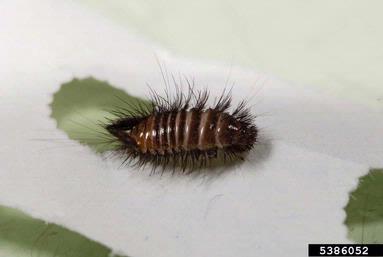Meet the Carpet Beetles
By Chris Williams on December 1, 2014.

Carpet Beetle Larva
Carpet beetles are a common indoor pest. If you look closely enough, you can probably find evidence of their presence in most homes. People usually don’t notice them, however, until they see the tiny adult beetles crawling up the walls.
There are at least four common species of carpet beetles in homes in Massachusetts and New Hampshire. The black carpet beetle is an oval, dark beetle. The other three carpet beetles are almost round in shape, about 1/8-inch long, and are various calico colors, splotched with patterns of black, brown, white, reddish-orange, or yellow. The colors aren’t obvious though unless you look at them under magnification.
Where Do You Find Carpet Beetles?
It’s the hairy-looking carpet beetle larvae that do the feeding damage in hidden locations. Don’t assume that carpet beetle larvae will be feeding just on carpets, or even just on woolens (see Carpet Beetles Are Not Just in Carpets). Besides wool carpets, the larvae will feed on fabrics (especially if soiled), hair, lint, feathers, hides, felt, dead animals and insects, and occasionally on stored foods (like dry pet food). The larvae are rarely seen, unless you are looking for them. They like dark, hidden areas on the underside of wool carpets, along baseboards, behind furniture, in voids—wherever hair, lint, dead insects, and crumbs accumulate. They can also be found in the nests of various animals, including birds, rodents, wasps, and bees (see Bee or Wasp Nests Can Be the Source of Carpet Beetles).
Is it Carpet Beetles or Clothes Moths?
If you notice slits in a rug or holes in fabrics, or hairs falling from an animal mount or your mother’s fur coat, carpet beetles could be to blame. It’s important to have a professional inspection since this type of damage could also be caused by clothes moths. Here are two clues that your problem is carpet beetles:
1) Carpet beetle larvae shed their skins frequently and you will find the light brown shed skins in the same places where the larvae are feeding. Look on the underside or deep in the pile of carpets to find the larvae. Fully grown larvae are about ¼-inch long, yellow-brown, covered with bristly hairs, and fairly active.
2) After the larvae pupate, the adult beetle emerges and, since it is attracted to light, it heads for windows or lights. It can be seen crawling up light-colored walls or flying to light, trying to get outside (see What Are Those Tiny Beetles Crawling Up My Walls?). The adult beetles do not do any feeding damage.
In homes, carpet beetle infestations often start in, and may be limited to, accumulations of lint, pet hair, and other household debris. You may be able to avoid or eliminate a carpet beetle infestation with thorough and frequent vacuuming, especially in those out-of-the-way places that are often overlooked. For a serious carpet beetle infestation, or for carpet beetles infesting a valued item, contact a professional exterminator.
Photo: Joseph Berger, Bugwood.org
Sign up for our biweekly email newsletter for more information about bugs and pests!